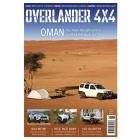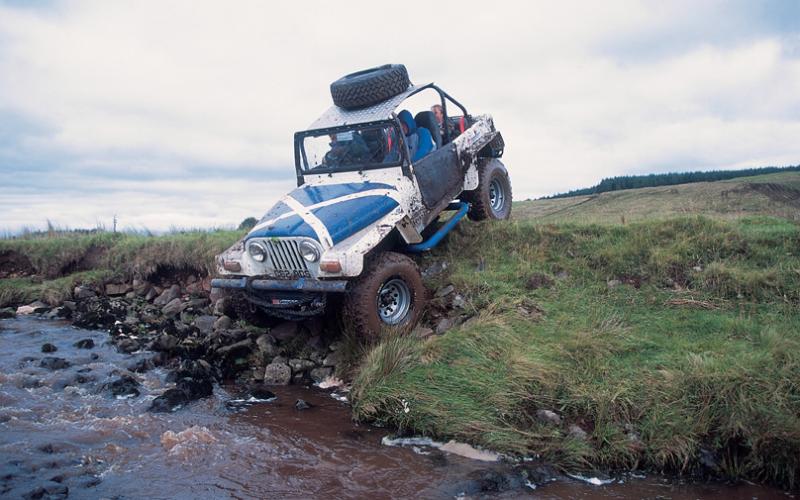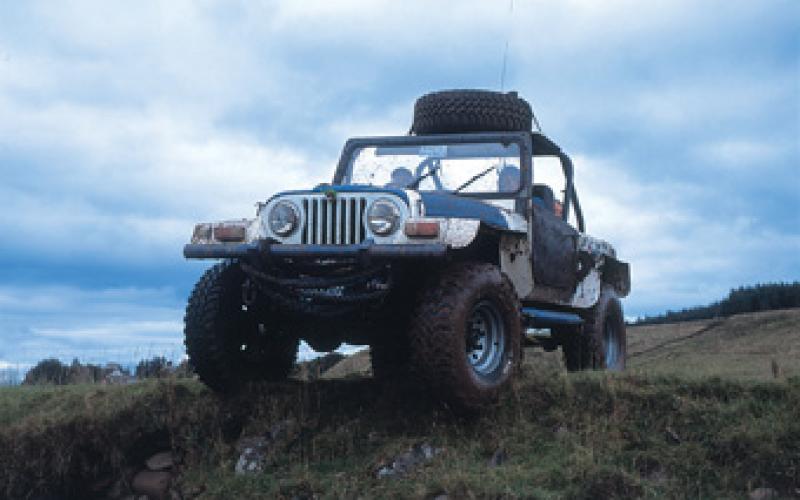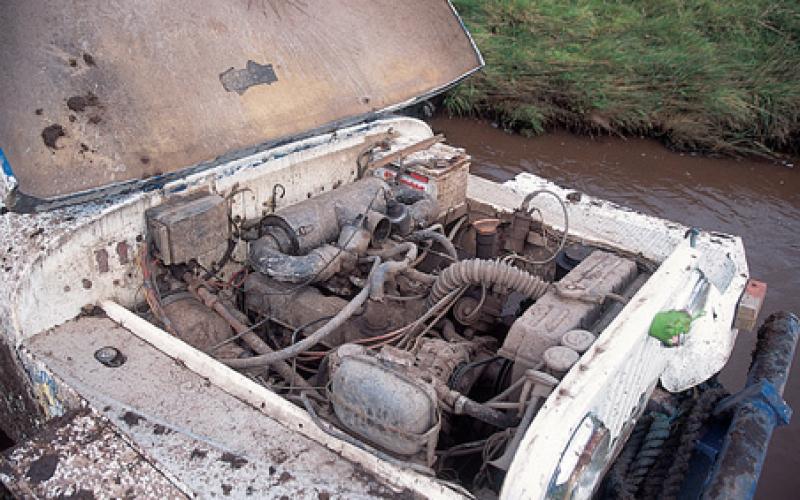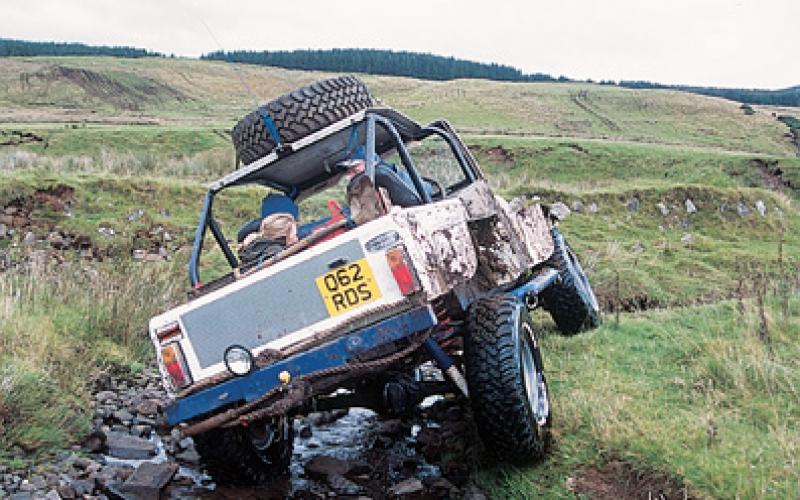Where Eagles Dare
George Imrie’s Eagle 4x4 only covers a few hundred miles a year – and its axles are rebuilt every six months. But don’t let that make you think it has an easy life.
If I spend more money on my Eagle,’ says George Imrie, ‘for the life of me I don’t think it would improve the motor.’ In a world of megabuck 4x4s boasting every last bit of equipment, surely we haven’t finally uncovered an off-roader who can actually claim to be happy with what he’s got?
It might sound rather like sacrilege but, despite the fact that it lacks a winch or any axle diff locks, the Eagle 4x4 you see in these pictures does everything its owner wants. Indeed, when he bought it, he even went so far as to strip out a load of electrical toys and extra lights he decided he wouldn’t be needing.
Since becoming the Eagle’s proud owner, in fact, about all George has done is replace its old 7.50s with a set of 35x12.50R15 BF Goodrich Mud-Terrains. That apart, it’s all been about keeping it running and fixing it when it’s stopped.
George’s lack of interest in lavishing any spare cash on the vehicle is all the more extraordinary when he estimates that the average annual maintenance budget for his off-road toy is less than £200. ‘It’s a very low-cost motor,’ he says, ‘though it is labour-intensive.’
He’s not wrong there, though the labour in question is definitely one of love. Having bought the vehicle two years ago, he’s pursued a policy of doing the bare minimum to keep it safe and road-legal, accepting that things will break and using them as an excuse to spend some quality time in the workshop when they do. Not an approach every off-roader would condone, but a perfectly valid way to go about the hobby when your vehicle is used for playdays and nothing but.
Oddly, considering George’s toy of choice was bought looking more or less as you see it here, it’s the latest vehicle to join the family’s long line of modified Range Rovers. He restored his first Land Rover when he was thirteen, and reckons he’s owned and tinkered with around fifteen since then. ‘I like my Range Rovers,’ he says, with an element of understatement. ‘They’re easy to work on.’
Given that he had already learned to use a welder and built his first go-kart at the age of eleven ‘out of a Marina van and two bedframes’, it’s no surprise that George’s interest in Solihull products soon started yielding a series of bobtailed and pick-up-bodied Range Rovers. He’s cut down two-door and four-door versions, even creating a bobtail with a detachable roof, the removal of which turned it into a convertible.
But the vehicle he’s proudest of is a two-door pick-up built from a four-door donor, which he sold shortly after buying the Eagle. ‘I cut the four-door shell just behind the B-pillar and grafted on the rear wing sections from a two-door, and shortened the chassis to 90 inches. The way it turned out, it looked like a sports car, because there was very little at the back, with only twelve inches of a pick-up bed and a rear parcel shelf. The petrol tank was below and there was enough room for the spare wheel to go vertically just behind the standard tailgate. It was pretty unusual. It was one of those Range Rovers that make you smile when you look at them, because it was just totally different. It actually reminded me of the Mercedes SLK, with the passenger compartment being so well back. The bonnet wasn’t any longer than normal, but the back was that short.’
On the subject of Range Rovers that look like something they’re not, back to the Eagle. If you’re thinking it looks like a CJ-7, well, that’s because it does.
But the Eagle kit is a little more than just a rebodying exercise. In fact, it’s a lot more, because it includes a new chassis. The vehicle rides on a ladder-frame structure composed of 4x2-inch box, supported by Rancho springs and shocks with an extra two inches of droop. The Eagle body has been modified slightly to accommodate the taller tyres, and now carries wheelarch extensions held in place by cable ties – a perfect example of George’s ultra-pragmatic approach to vehicle prep.
Behind the slatted ‘I’m a Jeep’ grille is a largely unmolested 3.5-litre Rover V8, which originally lived in an SD1. Running a set of SU carbs, this breathes through tubular manifolds but is otherwise pretty much exactly as Mr Buick intended. ‘I don’t see any need for a high air filter,’ says George, ‘due to the fact that when the water reaches the spark plugs it cuts out anyway. I’ve had the wheels below water, and it’s still happily running. That’s just over three feet – you’re starting to get wet feet inside the cabin, and the engine’s still running quite comfortably.’
Also completely standard is the Range Rover four-speed manual gearbox behind the engine, which George rates as being absolutely ideal for his purposes. Not because it’s a particularly nice box to row around (it’s not), but because its unpopularity means spares cost next to nothing. ‘I find it’s very reliable and will take a lot of punishment,’ he says. ‘And nobody wants a four-speed box so, if I destroy it, it’s easy to replace.
‘Having said that, I’ve had a three-speed auto sitting in the wings waiting to replace it. I think that would be a nice conversion, and it would make it easier for my daughter to drive because she’s only eleven. There are places where she’s allowed to drive, and she loves it. But I’m still waiting on the four-speed to break so badly that I can’t fix it.’
This is, emphatically, not for the want of trying. ‘It’s had two years of absolute punishment,’ George admits. ‘I wouldn’t say I’m a careful driver with it.’ Despite himself, he’s only had one really major drivetrain-trashing moment – and even then he still managed to drive out. ‘I took off across this boggy area that wasn’t actually quite as boggy as I thought. So I hit this drainage ditch at a fair old lick, faster than I was expecting, and it launched itself into the air. It came down nose-first, and there was a bang… Then the back came down, and there was another bang.
‘I reckon when it landed at the front, the wheels would have been spinning at such a rate that it’s probably done damage to the centre diff. And then there may be a possibility that with me still driving it, it’s started to take out the gears in the transfer box.’ Either way, the centre diff went off like a grenade, as did a rear halfshaft, and upon examination the transfer gear was missing the small matter of seven teeth. ‘By the time it came out,’ says George, ‘it was like a giant maraca. Second gear was the only one left – it would spin if you caught the seven teeth, but you could keep it on the move if you managed to miss them.
Even then, though, the famously unbreakable Torqueflite auto stayed in its corner. ‘I managed to repair the four-speed in something like four hours, that was stripping the burst gears and the centre diff out and putting it back together again. So the automatic is still sitting there, and it’s been sitting there for two years now.’
With four-speed parts going for a song, you get the impression that the new box might have a while to wait yet. And exactly the same approach means that even though, by George’s own admission, the vehicle tends to eat front axles, he’s not about to shell out on taking the heavy-duty route.
‘I use standard Range Rover internals, because of the sheer fact that there’s plenty of them lying about all over the countryside. For the price of a set of heavyduty halfshafts, I could probably buy a full set of axles and a chassis and an engine and gearbox. It’s usually easier for me to rebuild the axle every six months, and then that’s it until it destroys itself again.’
It’s a philosophy that’s borne out by a quick rundown of the front axle’s maintenance schedule from the Eagle’s first two years in George’s possession. Two halfshafts, a diff and a constant velocity joint sounds bad, but is probably no worse than you’d expect from a Range Rover axle getting a regular off-road pasting – particularly when, instead of the 205R16s it was designed to support, it’s got a couple of sodding great 35x12.50R15s bolted to it.
As George says, the Range Rover drivetrain is heavily over-engineered for a vehicle of the Eagle’s comparatively light weight. But those tyres are still going to tax any standard axle – especially when, as is the case at the back, the hub bearings have also got a couple of two-inch spacers to cope with.
Despite this, however, he’s very, very happy with his choice of rubber. ‘I’ve been off-road in two-wheel drive, after I broke that back halfshaft, and I still managed to get places that four-wheel drives that are working okay can’t manage. I put that down to the tyres – the 35-inch BFGs are absolutely superb. The only thing is it’s the old-style Mud-Terrains, which haven’t got the side lugs on, but I can honestly say that I wouldn’t go for any other tyre.’
The tyres are fitted on 15x10-inch chrome modulars, which pulls them in a little at the bead and causes what George describes as ‘a kind of balloon effect’. This is something he’s observed more on American vehicles than those over here, and he finds that in rocky conditions it helps protect the most vulnerable part of the tyre from damage.
‘The thing with the 35s,’ he says, ‘is that if I go first, if there’s a serious bit, I’ll usually dig the ruts out so deep that nobody else can get through them. Most people are still running 31s or 32s – there’s a few boys starting on 33s, but the 35s are still quite unusual. If you’re running 35s, if there’s a rut where a Land Rover’s been, you can walk it, no problem. But the rest of them are getting their axles stuck.’
When it comes to avoiding the mire, George also has a fairly robust approach to the concept of weight. ‘A lot of people when they’re off-roading, they’ve got absolutely everything in the back of their Land Rover. And as soon as they hit a soft bit they just disappear because they’re carrying too much. I limit myself to a hammer and chisel, wire, tape, jubilee clips – the basics. I keep probably three tow ropes, a selection of strops and some shackles, a high-lift jack and a shovel, and I can get by with most things.’
What that means is no winch, which for a dedicated off-road toy might sound a bit cavalier. But bearing in mind the fact that George never goes solo, and is dead against adding unnecessary weight or spending money for the sake of it, you can see why he hasn’t bothered. ‘There’s a pack of us who usually go off-roading together,’ he says. And they’ve developed a gameplan.
‘If we’re not too sure where we’re going, this one will head out over the soft bits – because there’s no problem to get it winched back. Whereas, if one of the heavier motors gets stuck, that’s where you start getting into problems. If I get across, the next person with a winch will head across, and if he gets stuck he can winch off me. So I’ve never felt a need for a winch – I’ve never been away by myself, so I’ve never had the problem.’
Despite the arch pragmatism of his approach, George says he does appreciate the loadsamoney vehicles you see competing at the top level on winch challenges and the like. Indeed, he hasn’t ruled out the idea of trying his Eagle against them at some stage. But for now, what you see here is a true back-to-basics off-road kit car that does exactly what its owner asks of it: ‘It’s fun off-roading that I do, and the vehicle’s perfectly suited to that. It goes, and it’s safe – and that’s just what I’m looking for.’
BFGOODRICH MUD-TERRAINS, RANCHO SPRINGS, EAGLE, KIT CARS



